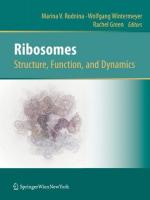|
This section contains 1,009 words (approx. 4 pages at 300 words per page) |

|
Ribosomes are the cellular organelles that carry out protein synthesis, through a process called translation. They are found in both prokaryotes and eukaryotes, these molecular machines are responsible for accurately translating the linear genetic code, via the messenger RNA, into a linear sequence of amino acids to produce a protein. All cells contain ribosomes because growth requires the continued synthesis of new proteins. Ribosomes can exist in great numbers, ranging from thousands in a bacterial cell to hundreds of thousands in some human cells and hundreds of millions in a frog ovum. Ribosomes are also found in mitochondria and chloroplasts.
Structure
The ribosome is a large ribonucleoprotein (RNA-protein) complex, roughly 20 to 30 nanometers in diameter. It is formed from two unequally sized subunits, referred to as the small subunit and the large subunit. The two subunits of the ribosome must join together to become active in protein synthesis. However...
|
This section contains 1,009 words (approx. 4 pages at 300 words per page) |

|


